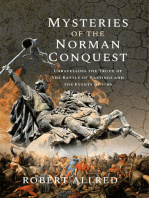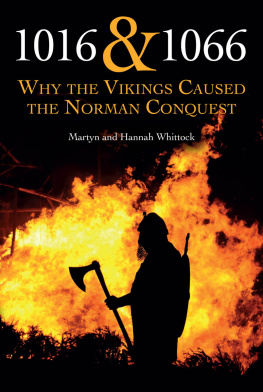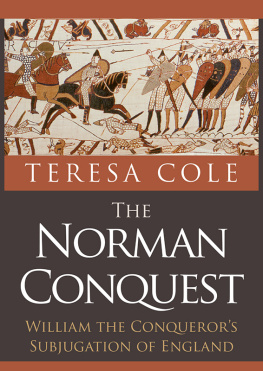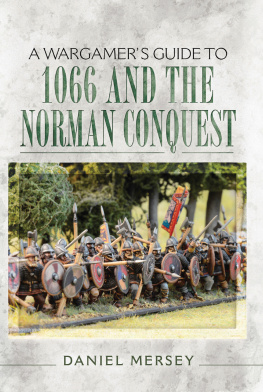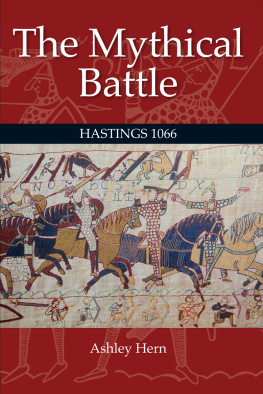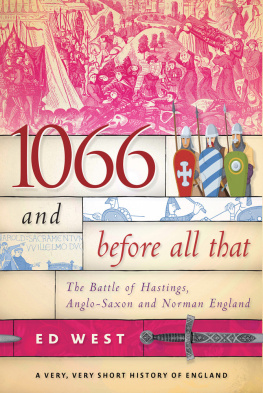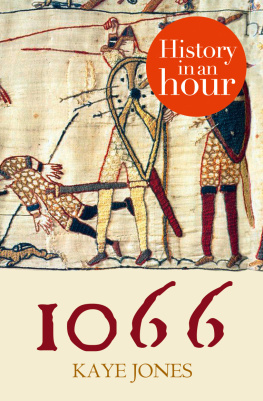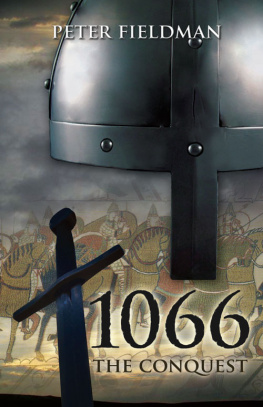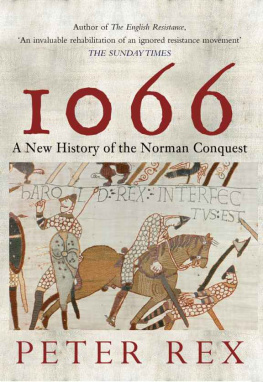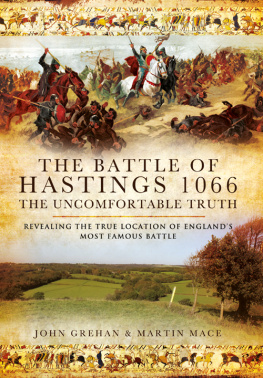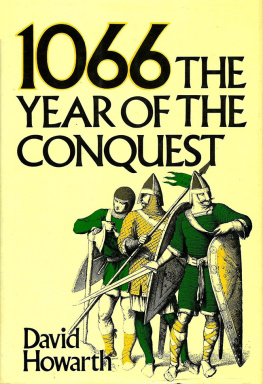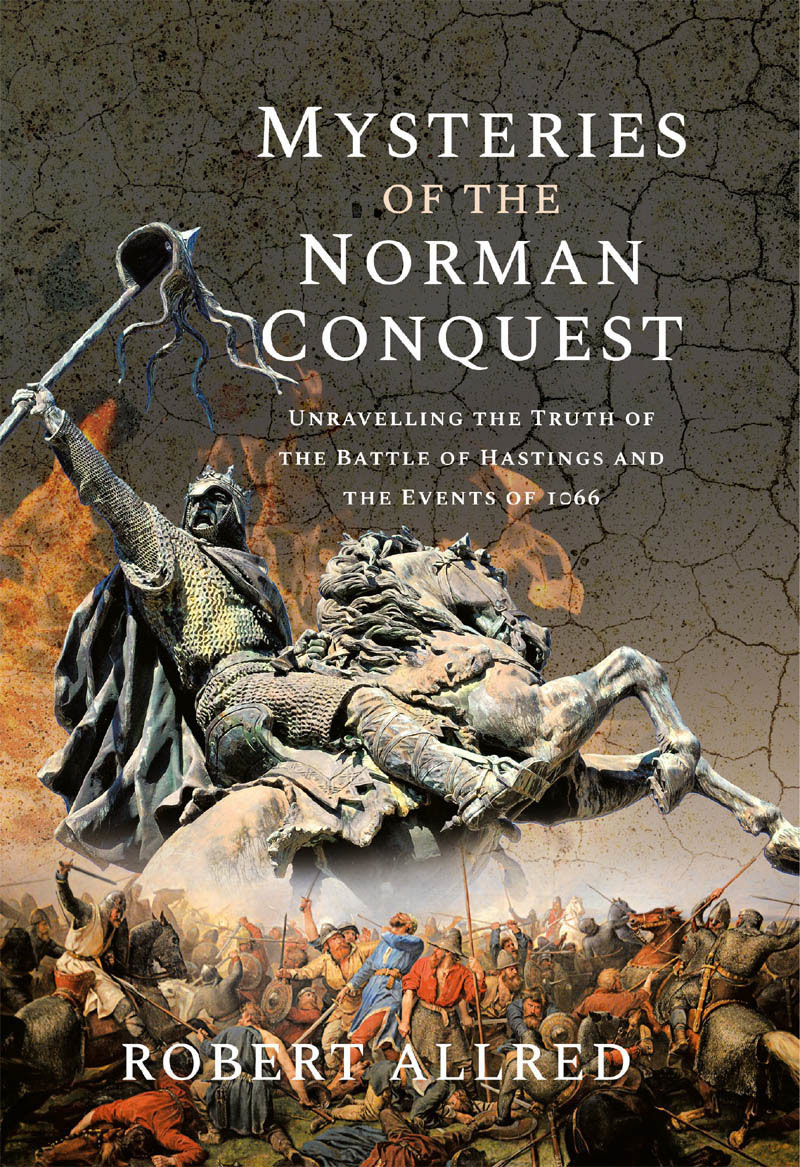
MYSTERIES OF THE NORMAN CONQUEST
MYSTERIES OF THE NORMAN CONQUEST
UNRAVELLING THE TRUTH OF THE BATTLE OF HASTINGS AND THE EVENTS OF 1066
ROBERT ALLRED


MYSTERIES OF THE NORMAN CONQUEST
Unravelling the Truth of the Battle of Hastings and the Events of 1066
First published in Great Britain in 2022 by
Frontline Books
An imprint of
Pen & Sword Books Ltd
Yorkshire - Philadelphia
Copyright Robert Allred, 2022
ISBN 978 1 39908 803 9
eISBN 978 1 39908 804 6
Mobi ISBN 978 1 39908 804 6
The right of Robert Allred to be identified as the author of this work has been asserted by him in accordance with the Copyright, Designs and Patents Act 1988.
A CIP catalogue record for this book is available from the British Library
All rights reserved. No part of this book may be reproduced or transmitted in any form or by any means, electronic or mechanical including photocopying, recording or by any information storage and retrieval system, without permission from the Publisher in writing.
Pen & Sword Books Ltd incorporates the Imprints of Aviation, Atlas, Family History, Fiction, Maritime, Military, Discovery, Politics, History, Archaeology, Select, Wharncliffe Local History, Wharncliffe True Crime, Military Classics, Wharncliffe Transport, Leo Cooper, The Praetorian Press, Remember When, Seaforth Publishing and Frontline Publishing.
For a complete list of Pen & Sword titles please contact
PEN & SWORD BOOKS LTD
47 Church Street, Barnsley, South Yorkshire, S70 2AS, England
E-mail: enquiries@pen-and-sword.co.uk
Website: www.pen-and-sword.co.uk
Or
PEN AND SWORD BOOKS
1950 Lawrence Rd, Havertown, PA 19083, USA
E-mail: Uspen-and-sword@casematepublishers.com
Website: www.penandswordbooks.com
Contents
This book is dedicated to my loving wife, Kim Van, and our sons, Austin and Jordan, for all of your love and support through all the years, through good times and not so good ones as well.
Acknowledgements
I must thank all of the dedicated professionals who have gone before me in solving the mysteries of the Norman Conquest, from medieval times until the present day. Among the unheralded heroes are John Grehan, at Pen and Sword Books for his sound advice in helping me make this into a publishable book. Also to be thanked are Pen and Sword editor Stephen Chumbley and editorial facilitator at Pen and Sword Lisa Hoosan. Then there are the numerous troupers in public, academic and private libraries who helped me track down and obtain the many sources utilised in conducting this investigation. I must, of course, thank my wife, Kim Van, and our sons, Austin and Jordan for all of their assistance spiritual and tangible. I must also include a sincere thank-you to Isidro Diaz for his contributions in crafting the maps appearing in this work. My gratitude extends to that anonymous editorial assistant who first reviewed my submission to Pen and Sword Books and who forwarded it to John Grehan, who was the proper man to provide the assistance required to make the publication of Mysteries of the Norman Conquest possible.
Thanks for all.
List of Illustrations
Fulford: The armies meet at Germany Beck. The Vikings seem to be checked. The Anglo-Saxons press the attack at the ford, where the Vikings briefly turn back while their main thrust along the River Ouse, across the marsh and into the woods on their left breaks through and bursts from the woods. Not shown: the Anglo-Saxon army is surprised, outflanked, routed, and hastily retreats to the relative safety of the walls of York. The outline shows the municipal limits of todays Fulford.
Stamford Bridge: The Viking army approaches from the south-east on the heights when they see the Anglo-Saxons rapidly advancing from the north-west on the high ground across the River Derwent.
Seeing that he is being attacked by a large force, the king of the Vikings sends an advance guard to block the bridge while the Viking army and its allies form a hedgehog defence on the heights, at what is now known as Battle Flats.
King Harold sends his mounted men in a dash across the ford just upstream from the bridge, along with the main body of infantry, while he accompanies a mounted column as they attack the bridge. There, after a brief struggle, King Harold and the second mounted group complete the encirclement of the Vikings.
Not shown: The Anglo-Saxons and Vikings engage in a bitter, drawn-out fight, reducing and eliminating the Viking army, killing Earl Tostig and King Harald Hardrada of Norway. Then, too late, a Viking relief force arrives, only to be defeated in turn. As dusk falls, the Anglo-Saxons pursue the few surviving Vikings all the way back to their ships, beached at Riccall.
The outline shows the town limits of modern Stamford Bridge.
Hastings, Phase One: Each side being aware of the presence of the enemy, advances the Normans from the south-east along the Hastings-to-London ridgetop road; the Anglo-Saxons from the north-west at their rallying point near the hoar apple tree on Caldbec Hill.
The Anglo-Saxon shield wall blocks the road as the Normans fan out, discovering that their flanking movements are blocked by marshes to the east, and a ravine to the west, which the Anglo-Saxons have fortified with sharpened stakes driven into the ground along the top of the slope on the northern edge of the narrow valley there.
Hastings, Phase Two: The Norman right flank remains checked behind marshes while the Norman main body is also stalled by a stout Anglo-Saxon defence on the ridgeway; but the Norman heavy infantry and cavalry press the attack on the left, across the fosse or fortified ditch (narrow, steep-sided valley or ravine). Seeing the threat, King Harold shifts from his initial command position on the high point just south of what is now the Marley Lane traffic circle, and advances into the present-day St Marys tract. As he does so, he sends reinforcements likely including many of his personal guards, his Huscarls to fortify and extend the Anglo-Saxon battle lines toward the south-west.
Hastings, Phase Three: The Norman heavy infantry and cavalry after an all-day fight of repeated attacks finally break through. Some of the cavalry swings wide, coming to grief in the flooded terrain at the southern edge of what has been the historically-accepted battlefield site below Battle Abbey. Meanwhile, Duke William and other knights close in and kill King Harold. Not shown: As evening falls, the Anglo-Saxons try to mount a last stand, likely at the present day St Marys Church, across from Battle Abbey, as the scattered survivors flee, many of whom are pursued and killed by Norman cavalry.
Hastings Today: The deployments of the armies are shown in relation to a few modern features of the town of Battle.
By Way of Introduction: Prelude and Preliminaries to Investigating the Battle of Hastings
I was eight years old when I first heard and read about the Norman Conquest of England. The year of the Conquest, I learned, was 1066. It would be a fateful year for a man Harold Godwinsson, Earl of Wessex become King Harold II, his family and his countrymen, as it would be for another man William, Duke of Normandy become William the Conqueror and also for his family and his countrymen. The events of 1066 would eventually influence the history of the entire planet.
Next page
